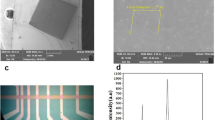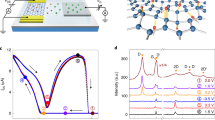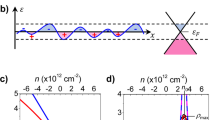Abstract
A high-quality junction between graphene and metallic contacts is crucial in the creation of high-performance graphene transistors. In an ideal metal–graphene junction, the contact resistance is determined solely by the number of conduction modes in graphene. However, as yet, measurements of contact resistance have been inconsistent, and the factors that determine the contact resistance remain unclear. Here, we report that the contact resistance in a palladium–graphene junction exhibits an anomalous temperature dependence, dropping significantly as temperature decreases to a value of just 110 ± 20 Ω µm at 6 K, which is two to three times the minimum achievable resistance. Using a combination of experiment and theory we show that this behaviour results from carrier transport in graphene under the palladium contact. At low temperature, the carrier mean free path exceeds the palladium–graphene coupling length, leading to nearly ballistic transport with a transfer efficiency of ~75%. As the temperature increases, this carrier transport becomes less ballistic, resulting in a considerable reduction in efficiency.
This is a preview of subscription content, access via your institution
Access options
Subscribe to this journal
Receive 12 print issues and online access
$259.00 per year
only $21.58 per issue
Buy this article
- Purchase on Springer Link
- Instant access to full article PDF
Prices may be subject to local taxes which are calculated during checkout




Similar content being viewed by others

References
Meric, I., Baklitskaya, N., Kim, P. & Shepard, K. L. RF performance of top-gated graphene field-effect transistors. IEEE International Electron Devices Meeting IEDM.2008.4796738, San Francisco, California (2008).
Lin, Y.-M. et al. 100 GHz transistors from wafer-scale epitaxial graphene. Science 327, 662 (2010).
Moon, J. S. et al. Epitaxial-graphene RF field-effect transistors on Si-face 6H–SiC substrates. IEEE Electron. Device Lett. 30, 650–652 (2009).
Xia, F., Farmer, D. B., Lin, Y.-M. & Avouris, Ph. Graphene field-effect transistors with high on/off current ratio and large transport band gap at room temperature. Nano Lett. 10, 715–718 (2010).
Xia, F. et al. Photocurrent imaging and efficient photon detection in a graphene transistor. Nano Lett. 9, 1039–1044 (2009).
Danneau, R. et al. Shot noise in ballistic graphene. Phys. Rev. Lett. 100, 196802 (2008).
Nagashio, K., Nishimura, T., Kita, K. & Toriumi, A. Metal/graphene contact as a performance killer of ultra-high mobility graphene—analysis of intrinsic mobility and contact resistance. IEEE International Electron Devices Meeting IEDM.2009.5424297, Baltimore, Maryland (2009).
Blake, P. et al. Influence of metal contacts and charge inhomogeneity on transport properties of graphene near the neutrality point. Solid State Commun. 149, 1068–1071 (2009).
Russo, S., Craciun, M. F., Yamamoto, M., Morpurgo, A. F. & Tarucha, S. Contact resistance in graphene-based devices. Physica E 42, 677–679 (2010).
Venugopal, A., Colombo, L. & Vogel, E. Contact resistance in few and multilayer graphene devices. Appl. Phys. Lett. 96, 013512 (2010).
Datta, S. Electronic Transport in Mesoscopic Systems Ch. 2 (Cambridge Univ. Press, 1995).
Anantram, M. P., Datta, S. & Xue, Y. Coupling of carbon nanotubes to metallic contacts. Phys. Rev. B 61, 14219–14224 (2000).
Nemec, N., Tomanek, D. & Cuniberti, G. Contact dependence of carrier injection in carbon nanotubes: an ab initio study. Phys. Rev. Lett. 96, 076802 (2006).
Nemec, N., Tomanek, D. & Cuniberti, G. Modeling extended contacts for nanotube and graphene devices. Phys. Rev. B 77, 125420 (2008).
Giovannetti, G. et al. Doping graphene with metal contacts. Phys. Rev. Lett. 101, 026803 (2008).
Khomyakov, P. A. et al. First-principles study of the interaction and charge transfer between graphene and metals. Phys. Rev. B 79, 195425 (2009).
Huard, B., Stander, N., Sulpizio, J. A. & Goldhaber-Gordon, D. Evidence of the role of contacts on the observed electron–hole asymmetry in graphene. Phys. Rev. B 78, 121402(R) (2008).
Golizadeh-Mojarad, R. & Datta, S. Effect of contact induced states on minimum conductivity in graphene. Phys. Rev. B 79, 085410 (2009).
Martin, J. et al. Observation of electron–hole puddles in graphene using a scanning single-electron transistor. Nature Phys. 4, 144–148 (2008).
Cheianov, V. V. & Fal'ko, V. Selective transmission of Dirac electrons and ballistic magnetoresistance of n–p junctions in graphene. Phys. Rev. B 74, 041403(R) (2006).
Katsnelson, M. I., Novoselov, K. S. & Geim, A. K. Chiral tunnelling and the Klein paradox in graphene. Nature Phys. 2, 620–625 (2006).
Cheianov, V. V., Fal'ko, V. & Altshuler, B. L. The focusing of electron flow and a Veselago lens in graphene p–n junctions. Science 315, 1252–1255 (2007).
Fogler, M. M., Novikov, D. S., Glazman, L. I. & Shkovskii, B. I. Effect of disorder on a graphene p–n junction. Phys. Rev. B 77, 075420 (2008).
Cayssol, J., Huard, B., & Goldhaber-Gordon D. Contact resistance and shot noise in graphene transistors. Phys. Rev. B 79, 075428 (2009).
Sonin, E. B. Effect of Klein tunneling on conductance and shot noise in ballistic graphene. Phys. Rev. B 79, 195438 (2009).
Low, T., Hong, S., Appenzeller, J., Datta, S. & Lundstrom, M. S. Conductance asymmetry of graphene p–n junction. IEEE Trans. Electron. Dev. 56, 1292–1299 (2009).
Tersoff, J. & Hamann, D. R. Theory and application for the scanning tunneling microscope. Phys. Rev. Lett. 50, 1998–2001 (1983).
Schroder, D. K. Semiconductor Material and Device Characterization (Wiley, 1998).
Kane, A. A. et al. Graphitic electrical contacts to metallic single-walled carbon nanotubes using Pt electrodes. Nano Lett. 9, 3586–3591 (2009).
Franklin, A. D. & Chen, Z. Length scaling of carbon nanotube transistors. Nature Nanotech. 5, 858–862 (2010).
Acknowledgements
The authors are grateful to B. Ek and J. Bucchignano for technical assistance and the Defense Advanced Research Projects Agency for partial financial support through the Carbon Electronics for Radio-frequency Applications program (contract FA8650-08-C-7838). F.X. is indebted to C.Y. Sung for his encouragement. V.P. gratefully acknowledges stimulating discussions with J. Tersoff.
Author information
Authors and Affiliations
Contributions
All authors discussed the results and commented on the manuscript.
Corresponding authors
Ethics declarations
Competing interests
The authors declare no competing financial interests.
Supplementary information
Supplementary information
Supplementary information (PDF 617 kb)
Rights and permissions
About this article
Cite this article
Xia, F., Perebeinos, V., Lin, Ym. et al. The origins and limits of metal–graphene junction resistance. Nature Nanotech 6, 179–184 (2011). https://doi.org/10.1038/nnano.2011.6
Received:
Accepted:
Published:
Issue Date:
DOI: https://doi.org/10.1038/nnano.2011.6
This article is cited by
-
Effect of fabrication process on contact resistance and channel in graphene field effect transistors
Scientific Reports (2024)
-
Graphene-based hybrid plasmonic optical electro-absorption modulator on InP platform
Optical and Quantum Electronics (2024)
-
Ballistic two-dimensional InSe transistors
Nature (2023)
-
One-dimensional semimetal contacts to two-dimensional semiconductors
Nature Communications (2023)
-
Low contact resistance side-interconnects strategy for epi-graphene based electronic integration
Journal of Materials Science: Materials in Electronics (2022)


